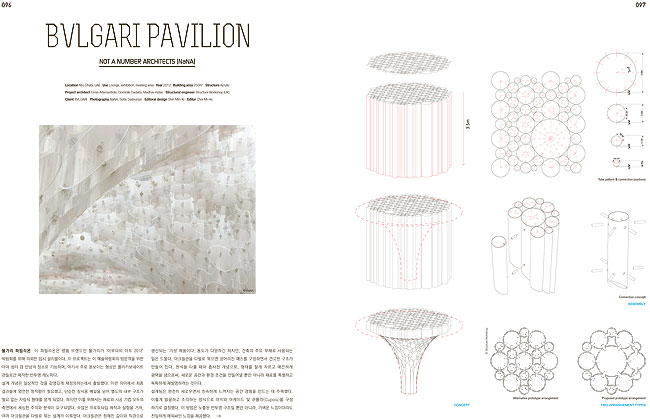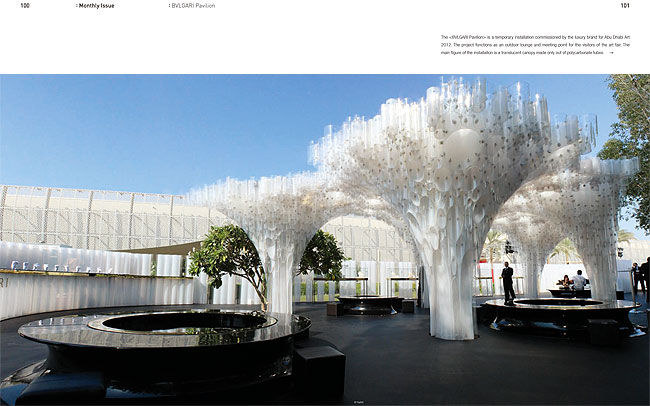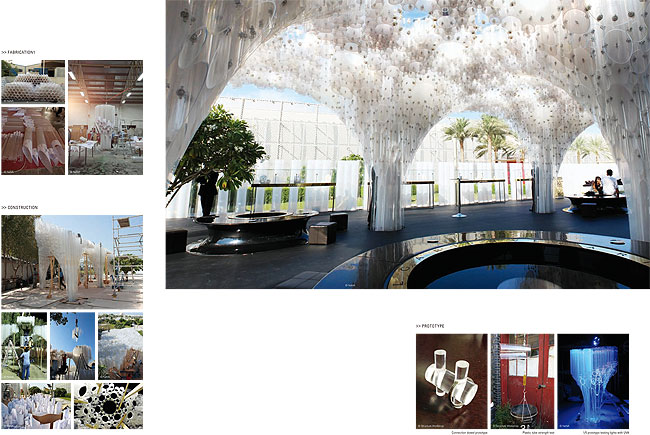Bvgari Pavilion
Not a Number Architects (NaNA)



www.nan-a.eu
불가리 파빌리온 이 파빌리온은 명품 브랜드인 불가리가 ‘아부다비 아트 2012’ 박람회를 위해 의뢰한 임시 설치물이다. 이 프로젝트는 이 예술박람회의 방문객을 위한 야외 쉼터 겸 만남의 장소로 기능하며, 여기서 주로 돋보이는 형상은 폴리카보네이트 관들로만 제작한 반투명 캐노피다. 설계 개념은 일상적인 것을 감명깊게 재정의하는데서 출발했다. 이런 의미에서 최종 결과물에 엄연한 정직함이 필요했고, 단순한 장식용 베일을 넘어 별도의 내부 구조가 필요 없는 자립식 형태를 얻게 되었다. 하지만 이를 위해서는 재료와 시공 기법 모두의 측면에서 세심한 주의와 분석이 요구되었다. 수많은 프로토타입 제작과 실험을 거쳐, 여러 아크릴관을 다발로 묶는 설계가 이뤄졌다. 아크릴관은 정해진 길이와 직경으로 생산되는 ‘기성’제품이다. 용도가 다양하긴 하지만, 건축의 주요 부재로 사용되는 일은 드물다. 아크릴관을 다발로 묶으면 덩어리진 매스를 구성하면서 견고한 구조가 만들어 진다. 원석을 다룰 때와 흡사한 개념으로, 형태를 잘게 자르고 매끈하게 광택을 냄으로써, 새로운 공간과 환경 조건을 만들어낼 뿐만 아니라 재료를 특별하고 독특하게 재발명하려는 것이다. 설계팀은 완전히 새로우면서 친숙하게 느껴지는 공간 경험을 만드는 데 주력했다. 이렇게 발굴하고 조각하는 방식으로 아치와 아케이드 및 큐폴라(Cupola)를 구성 하기로 결정했다. 이 방법은 노출된 반투명 구조일 뿐만 아니라, 가벼운 느낌이더라도 친밀하게 에워싸인 느낌을 제공했다. 캐노피의 원형 다발 구성은 다섯 지점에서 지면과 닿으며 별도의 내부구조가 필요 없이 자립식 궁륭(Vault) 구조를 만들어내면서, 형태적 표현과 구조적 논리를 하나의 단일 체계로 수렴한다. 이 디자인은 총 2,272개의 관으로 구성 되며, 관들 사이에는 약 1만 개의 개별 접합부들이 있어 최종 무게는 거의 6톤에 달한다. 낮에는 이 파빌리온이 시시각각 달라지는 태양광의 조건을 조절해가며 활용하지만, 밤에는 마치 물이 파빌리온의 다양한 부분을 감추고 드러내듯 빛이 구조물을 관통하며 흐르는 색다른 경험을 제공한다.
글 제공: 낫 어 넘버 아키텍츠 (NaNA)
이 프로젝트에서 플라스틱을 주재료로 사용한 이유는 무엇 이며, 사용된 플라스틱의 종류와 그 특성에 대해 설명해달라.
이 프로젝트를 시작할 때는 플라스틱만 고려한 게 아니었다. 금속관을 사용하는 것도 대안이었는데, 금속관을 사용했으면 생산 과정에서 이점이 많았을 것이다. 금속관의 레이저 커팅은 플라스틱과 반대로 철강산업에 많이 활용되고 있으며 도면 파일을 공장에 넘기는 과정에서 바로 적용할 수 있다. 반면에 우리는 캐노피에 투명한 재료를 더해 전체 매스와 캐노피의 이미지를 한층 가볍게 하고 싶었다. 이 프로젝트가 설치와 해체가 중요한 임시 설치작업으로 설계된 터라, 이러한 가벼움이야말로 바람직하다고 느껴졌다. 두 가지 유형의 플라스틱을 사용했는데, 플라스틱 관에는 아크릴을, 관과 관 사이의 장부촉(dowel) 이음에는 폴리카 보네이트를 사용했다. 캐노피를 통과하는 빛을 적절히 분산 시키는 투명관과 반투명관을 모두 아크릴로 제작할 수 있었다. 반면에 구조를 함께 고정할 이음의 디테일은 강한 수직 응력에 저항할 단단한 봉들로 만들어야 했고, 이를 위해 구조 엔지니어들은 아크릴보다 내충격성이 200배에 달할 수 있는 폴리카보네이트를 제안했다.
플라스틱을 다루는 건축물의 설계, 시공 과정의 주안점은 무엇이라고 생각하는가?
플라스틱을 구조 부재로 사용할 때는 그 재료적 속성을 철저히 조사해야 하고, 대규모 구조물에 적용하기 전에 실시간 시험을 해봐야 한다. 게다가 플라스틱마다 환경에 노출될 때 발생 하는 노화의 속도가 다르므로, 유지보수뿐만 아니라 날씨와 자외선에 대한 저항성도 고려해야 한다.
건축가로서 생각하는 플라스틱의 재료적인 매력과 그 가치는 무엇인가?
플라스틱은 지금껏 단단하고 무겁게 인식되어온 건축 부재를 투명하고 가볍게 만들 수 있는 거 같다. 아울러 생산에서 재 사용에 이르기까지 더욱 환경 친화적일 수 있다는 점도 빼놓을 수 없다.
높은 가공성을 가진 플라스틱에 3D프린팅등의 신기술을 적용한 프로젝트들이 나타나는 추세이다. 이에 대한 당사의 전망은 무엇인가?
우리는 건축에 평범한 기술을 평범하지 않게 활용하는 편이다. 현재는 신기술에만 의존하는 건설보다도, 프로젝트와 관련한 공간의 생산에 주된 관심을 두고 있다.
현재 주목하고 있는 재료는 어떤 것이며, 앞으로 주목 받을 재료는 무엇이라 생각하나?
이상하게 들릴 수 있겠지만, 현재 흙 벽돌에 관심을 두고 있다. 우리가 관여하는 복원 프로젝트가 있어서 그렇다. 우리는 모든 종류의 재료로 실험하면서 각 재료가 어떻게 우리의 디자인과 프로젝트 디테일을 결정할 수 있는지 알아보는 걸 좋아한다.
인터뷰이: 낫 어 넘버 아키텍츠 (NaNA)
The
Text offer: Not a Number Architects (NaNA)
Is there any particular reason for using Plastic as main material for this project? And what types of Plastic have you used in this project, and what general properties do they have?
Plastic was not our only option in the beginning of this project. Using metal tubes was an alternative plan which would have a number of advantages in terms of the production process. Tube laser-cutting of metal as opposed to plastic is something that many steel industries do and can be straightforwardly applied in a file-tofactory process. On the other hand we wanted to achieve a certain lightness in the overall mass and image of the canopy by adding the element of transparency. That lightness felt also right in a literal way as the project was designed to be a temporary installation where setting-up and dismantling plays a crucial role. Two types of plastic were used: acrylic for the tubes and polycarbonate for the dowel connections between the tubes. By choosing acrylic we were able to use both transparent and translucent tubes in order to control the diffusion of the light through the canopy. On the other hand the connection detail was made out of solid rods that had to withstand great vertical stresses in order to keep the structure together, so the structural engineers proposed polycarbonate as it can have 200 times the impact resistance of acrylic.
About what should we be careful when designing and undertaking construction with Plastic?
When plastic is used as a structural element its material properties should be thoroughly examined and real-time tested before any large scale application. Furthermore different plastics age differently when exposed to the environment so weather and UV resistance as well as maintenance should be taken into account.
What do you think as an architect are the advantages and values of Plastic as a building material?
We feel that it has the capacity to bring transparency and lightness in architectural elements that until now were meant to be solid and heavy. At the same time we should not dispense with its capacity to get more environmentally friendly from its production through to its reusability. A recent trend is the emergence of projects based on new technology such as applying three-dimensional printing to plastic which is easily shaped.
How about your expectation for this trend?
We tend to use conventional technology in an unconventional way in our architecture. Our main concern for now is the production of space in relation to a project rather than building exclusively on a new technology.
What material are you looking at now? And do you think what material will get much attention in the future?
As strange as it may sound we are into mud bricks right now as we are involved in a restoration project. We love to experiment with all sorts of materials and see how each one can in a way dictate our design and detailing of a project.
Interviewee: Not a Number Architects (NaNA)
건축문화 2016년 6월호 [Monthly Issue]페이지 © 에이엔씨출판(주)